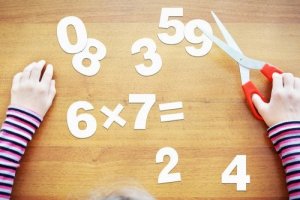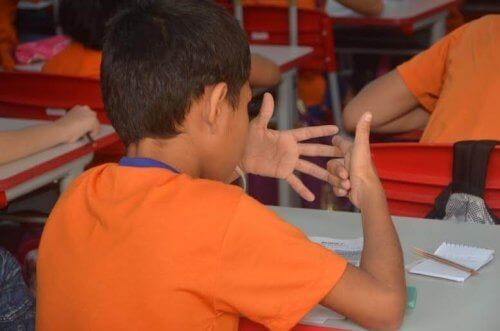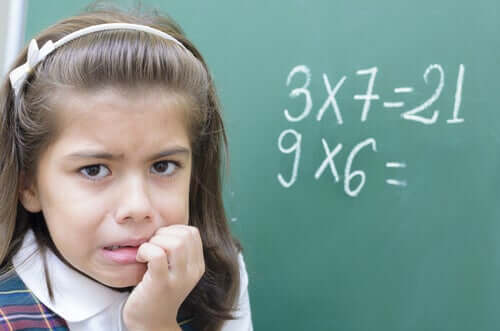Tricks for Children to Learn Multiplication Tables

In order for children to learn their multiplication tables well, you’ll need to wait for the right moment. Children first need to understand what multiplication is and what it’s for. By knowing the benefits of this mathematical operation, it’ll be easier for them to understand it and put it into practice.
These tips are simple and a lot of fun. Tricks for learning multiplication tables for children will help them remember them throughout their lives. Interactive games, videos, songs and other techniques are ideal to help them memorize them.
Before we start teaching tricks to help children learn their multiplication tables, we need to introduce some basic principles:
- Multiplying 3 x 4 is the same as multiplying 4 x 3
- The result of multiplying any number by zero will always be zero
- All numbers multiplied by 1 will give the same answer
- In the table of 2, you add the two numbers together
- When you multiply by 5 you’ll always end up with 5 or 0
- To learn the table of 7 you can use days of the week: multiplying by 1 is equal to a week or 7 days, by 2, equal to two weeks or 14 days
- If you multiply by 10, you just need to add a zero to the number that’s multiplied
Tips for children to learn multiplication tables
Children’s best tool for learning will be their hands. You can also use pencils and paper or cardboard and colors. Videos and interactive games are also helpful.

For both and for all
Learning to multiply by two can be very simple, just like a game. Just take a piece of cardboard and draw two rows. In one, we place the number 2 and in the other each number that it’s going to be multiplied by, up to 10.
For the second result, the answer will be double that of the previous multiplication, and we’ll simply need to add two. So, 2 x 1 is 2, and 2 x 2 will be double the first answer (4). We then add two to get a total of 6.
This idea is then repeated four times: 2 x 4 is double 2 x 2, and the next time we add 2 to get 10. We can then see that 2 x 6 is the double of 2 x 3, and we had two again to get 14.
In the next box, 2 x 8 is double 2 x 4 and we add two again to get 18. To the last number, i.e. 2 x 10, we add a 0 after the 2.
The above trick can be used for any number you want to multiply.
Tables 6 to 9
Another trick for children to learn multiplication tables from 6 to 9 is to number the fingers of each hand from 6 to 10 (the thumbs will be 10 and the pinkies 6). It never fails.
If we want to know how much 7 x 8 is, we join the finger marked seven with the number eight of the other hand. Those above the joined fingers will represent the tens; those below will represent the units.
In this way, we’ll have three tens on one hand and two on the other for a total of five tens. We’ll have two fingers left on one hand and three on the other, so then multiply those numbers and the result is six. 7 x 8 equals 56.
9 up and down
One trick to learning the nine times table is to create two columns. In the first column, the numbers from 0 to 9 are placed in ascending order. In the second column, the same numbers are placed, but in descending order, from 9 to 0. When crossing them, the correct results will be obtained, from 9 to 90.
Here’s another trick related to this number: If we want to know how much 9 x 6 is, we assign numbers from 1 to 10 to each of our fingers. As we’re multiplying by 6, we’ll count five fingers and bend over the sixth. We then count the remaining fingers – there are four of them and this gives us the answer 54.
Try it out with the other numbers, always remembering to bend over the last finger that you count and then count the remaining fingers to give you the second digit.

Decomposing the factors
One way to learn multiplication tables is to break down one of the factors. For example, if we want to multiply 9 x 8, we can decompose 8; we would then have 9 x 4 and 9 x 4. The result is 36 plus 36 which equals 72.
Another option is to decompose the 9 and then we would have, for example, 5 x 8 and 4 x 8. This is equal to 40 plus 32, which totals 72. As we can see, these can be quite useful in practice.
These simple tricks for learning multiplication tables for children will be of great benefit. The student won’t have to memorize all the tables, and will be able to have fun and acquire knowledge at the same time, almost without realizing it.
In order for children to learn their multiplication tables well, you’ll need to wait for the right moment. Children first need to understand what multiplication is and what it’s for. By knowing the benefits of this mathematical operation, it’ll be easier for them to understand it and put it into practice.
These tips are simple and a lot of fun. Tricks for learning multiplication tables for children will help them remember them throughout their lives. Interactive games, videos, songs and other techniques are ideal to help them memorize them.
Before we start teaching tricks to help children learn their multiplication tables, we need to introduce some basic principles:
- Multiplying 3 x 4 is the same as multiplying 4 x 3
- The result of multiplying any number by zero will always be zero
- All numbers multiplied by 1 will give the same answer
- In the table of 2, you add the two numbers together
- When you multiply by 5 you’ll always end up with 5 or 0
- To learn the table of 7 you can use days of the week: multiplying by 1 is equal to a week or 7 days, by 2, equal to two weeks or 14 days
- If you multiply by 10, you just need to add a zero to the number that’s multiplied
Tips for children to learn multiplication tables
Children’s best tool for learning will be their hands. You can also use pencils and paper or cardboard and colors. Videos and interactive games are also helpful.

For both and for all
Learning to multiply by two can be very simple, just like a game. Just take a piece of cardboard and draw two rows. In one, we place the number 2 and in the other each number that it’s going to be multiplied by, up to 10.
For the second result, the answer will be double that of the previous multiplication, and we’ll simply need to add two. So, 2 x 1 is 2, and 2 x 2 will be double the first answer (4). We then add two to get a total of 6.
This idea is then repeated four times: 2 x 4 is double 2 x 2, and the next time we add 2 to get 10. We can then see that 2 x 6 is the double of 2 x 3, and we had two again to get 14.
In the next box, 2 x 8 is double 2 x 4 and we add two again to get 18. To the last number, i.e. 2 x 10, we add a 0 after the 2.
The above trick can be used for any number you want to multiply.
Tables 6 to 9
Another trick for children to learn multiplication tables from 6 to 9 is to number the fingers of each hand from 6 to 10 (the thumbs will be 10 and the pinkies 6). It never fails.
If we want to know how much 7 x 8 is, we join the finger marked seven with the number eight of the other hand. Those above the joined fingers will represent the tens; those below will represent the units.
In this way, we’ll have three tens on one hand and two on the other for a total of five tens. We’ll have two fingers left on one hand and three on the other, so then multiply those numbers and the result is six. 7 x 8 equals 56.
9 up and down
One trick to learning the nine times table is to create two columns. In the first column, the numbers from 0 to 9 are placed in ascending order. In the second column, the same numbers are placed, but in descending order, from 9 to 0. When crossing them, the correct results will be obtained, from 9 to 90.
Here’s another trick related to this number: If we want to know how much 9 x 6 is, we assign numbers from 1 to 10 to each of our fingers. As we’re multiplying by 6, we’ll count five fingers and bend over the sixth. We then count the remaining fingers – there are four of them and this gives us the answer 54.
Try it out with the other numbers, always remembering to bend over the last finger that you count and then count the remaining fingers to give you the second digit.

Decomposing the factors
One way to learn multiplication tables is to break down one of the factors. For example, if we want to multiply 9 x 8, we can decompose 8; we would then have 9 x 4 and 9 x 4. The result is 36 plus 36 which equals 72.
Another option is to decompose the 9 and then we would have, for example, 5 x 8 and 4 x 8. This is equal to 40 plus 32, which totals 72. As we can see, these can be quite useful in practice.
These simple tricks for learning multiplication tables for children will be of great benefit. The student won’t have to memorize all the tables, and will be able to have fun and acquire knowledge at the same time, almost without realizing it.
All cited sources were thoroughly reviewed by our team to ensure their quality, reliability, currency, and validity. The bibliography of this article was considered reliable and of academic or scientific accuracy.
- Mª de las Mercedes Rodríguez-Hernández. José Luis González Fernández (Universidad de Castilla-La Mancha. España). 2015. Tablas de multiplicar con sabor a juego. Extraído de: http://www.sinewton.org/numeros/numeros/90/Articulos_01.pdf
- espartero2primaria. (2010). Trucos para multiplicar. Extraído de: https://espartero2primaria.files.wordpress.com/2010/03/trucos-para-multiplicar.pdf
This text is provided for informational purposes only and does not replace consultation with a professional. If in doubt, consult your specialist.








